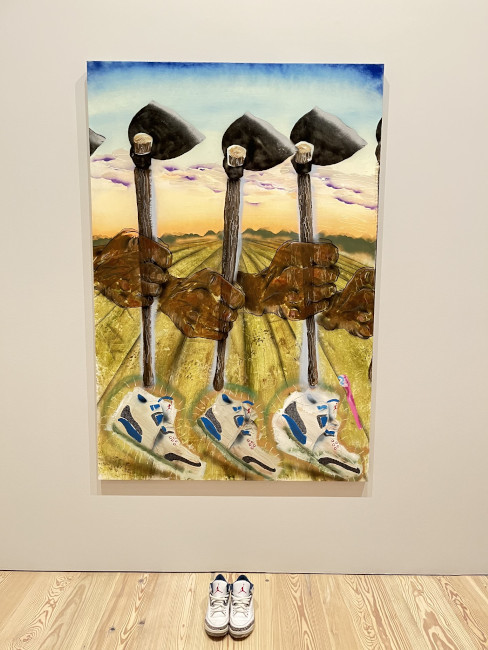Inheritance: Searching Past, Present, and Future Identities at the Whitney

The poet Rio Cortez speaks of being “framed by our future knowing”— between our foremothers and the descendants we will never know. We have all experienced the sense of limbo, being caught between the past and the future, looking for a way to define our present selves. Artists in particular are caught up in this journey through time and the need to interpret the path they take.
The Whitney Museum of American Art has done a commendable job of gathering an impressive array of artists who have taken on the challenge. Through painting, sculpture, photography, film, video, mixed media, and installation, these participants have left clues for us to follow them on their journeys. What better way to start than with the act of birth itself?

Artist Mary Kelly filmed herself at full-term pregnancy in Antepartum (1973). A prologue to a later exploration of motherhood she produced, the viewer watches a giant black-and-white Super 8 silent demonstration as the fetus moves under her skin. This imagery never ceases to create a sense of wonderment in the viewer. Denda McCannon’s Pregnant Woman (1977), a boldly detailed linoleum-cut collagraph, is just as eye-catching. The subject’s body profile and straight-on glance almost dare us not to look away.
The death of a parent is not an easy event to convey, and Maggie Lee’s video Mommy (2012-15) makes a laudable and touching attempt to show how a teenage daughter deals with the aftermath. Through a collage of sorting through rooms and miscellaneous objects—what to keep and what to discard—she provides a visceral reminder of what is lost and remembered.

The struggle of oppression, survival, and renewal is not lost on a number of these artists. The Road by Kevin Bensly is a massive slab sculpture that evokes the Great Migration, when millions of African Americans fled the rural South for urban opportunities in the North. Simple colorful iconography speaks volumes, with guinea fowl feathers, shoelaces, and other garments, including a ragged T-shirt that advises “soak in the sun” amidst blazing sunlight and a winding road filling one side. On the opposite side, the blackened cotton forma of a car and tire wheels present an industrial future.
Pat Phillips’s The Farm (2018) is an edgier work, with a row of three brown hands grasping hoes with a trio of blue-and-white sneakers framing the base of the painting -- with one pair placed on the museum floor below the canvas. A clever addition perhaps but the imagery in the painting can stand on its own. The title refers to both the Louisiana State Penitentiary (also known as Angola, after a former slave plantation) and the continuum of enslaved people.

The most beautifully rendered example of an answer to power can be found in Strike (2018) by Hank Willis Thomas. It holds a central position in one of the exhibition rooms—a stainless-steel sculpture with a mirror finish inspired by a lithograph in the museum collection. Although it references a unionized struggle of a black worker resisting a police officer’s nightstick, in its formidable elegance it speaks eloquently across the generations.
Ancestral homage in such an exhibition is its own raison d’etre, and the best example on display is John Outterbridge’s The Elder, Ethnic Heritage Series (1979). This Los Angeles-based artist draws on folk art that employs the iconography of totems, religious relics, and other devotional objects to convey the visual culture of the dispossessed. His chosen figure lifts arms toward the sky—no words needed to convey its emotional staying power. Another homage to African ancestry can be found in Thaddeus Mosley’s Repetitive Reference (2020) depicting antelope headdresses made by the Bamana peoples of Mali. Though cast in bronze, it retains the texture of wood from this masterful wood carver.

Another distinctive homage to an indigenous people is Red Exit (2020) by Andrea Carlson. Rooted in the native mythology of the Ojibwe, it’s a gorgeous narrative of that culture. Her story’s imagery spans a linear grid with the most striking image -- that of a loon -- or Earth Diver in its V-shaped center.
Photography plays a decisive role in this exhibition, and there are many fine examples in solo as well as narrative works. Deana Lawson has made her mark in recent years, particularly in contemporary renditions of family and friends. In The Garden, Gemena, DR Congo (2015), she has reimagined The Garden of Eden. Little narrative if any is required to understand the tender moment caught between her nude subjects. Also of note are the double exposure portraits, such as I Am U (1995) by Sophie Rivera, which manage to give a layered picture of two different children. This was part of a series by the artist who worked to change the negative postwar depictions she witnessed of her fellow Nuyoricans.

The title of the exhibition, Inheritance, was based on Ephraim Asili’s first feature-length film, a re-enactment of the Black Marxist collective, MOVE. This black liberation organization, founded in 1972, was bombed by the Philadelphia police in 1985 due to numerous complaints in the community. The film is presented in its entirety, and though most museumgoers will only experience it in brief segments, it serves as an example of how its filmmaker used his subject matter to explore what kind of organization can exist to uphold inherited freedoms within the society at large.
This is an exhibition that raises a number of questions about how we as individuals respond to our world, given our highly individualized backgrounds, combined with our own hopes and dreams, within a constantly changing, uncertain future.
The exhibit is on view through February 2024.
Author Bio:
Sandra Bertrand is Highbrow Magazine’s chief art critic.
For Highbrow Magazine
Image Sources:
--All images courtesy of Sandra Bertrand.































































































































































































































































































































